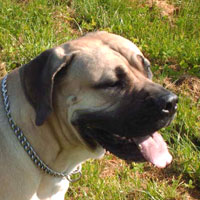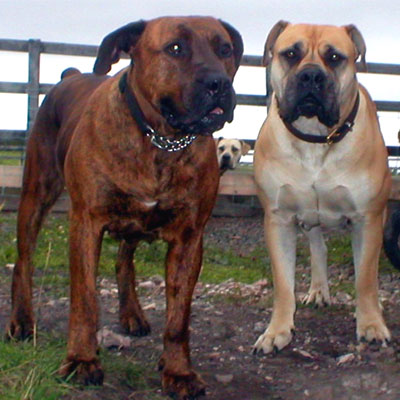
 Developed in South Africa by the European pioneers in the 1600's, the Boerboel is a result of crossing the imported Bullenbeissers with Great Danes, old British Bulldogges and local African hounds, as well as with other large working mastiffs of Europe, followed by generations of inbreeding and planned periodical outcrossing, using English Mastiffs, English Bullmastiffs, English Bullterriers, Dutch Mastiffs and Saint Bernards, among other breeds. A superb farm watchdog, property and personal protection dog and occasional hunter, this impressive bandog has been the dog of choice for landowners in its native land for a great number of years, but the urbanization of South Africa in the 20th century brought with it what seemed at the time to be the certain death to the Boerboel, by exposing the breed to many other dogs of various type and origin. Luckily, a few dedicated breeders managed to ensure the survival of a sufficient population of pure examples and, similar to numerous other salvation projects of the 1980's, the old-type Boerboel was reincarnated and has been fully standardized. In Africa, the breeding of Boerboels is regulated by a few associations, namely the HBSA, SABT and the EBBASSA, but there is still a handful of private breeding farms maintaining their own lines with little regard to the outside world. With the ever-increasing popularity and worldwide interest in the breed in recent years, the number of Boerboels outside of Africa is also steadily growing.
Developed in South Africa by the European pioneers in the 1600's, the Boerboel is a result of crossing the imported Bullenbeissers with Great Danes, old British Bulldogges and local African hounds, as well as with other large working mastiffs of Europe, followed by generations of inbreeding and planned periodical outcrossing, using English Mastiffs, English Bullmastiffs, English Bullterriers, Dutch Mastiffs and Saint Bernards, among other breeds. A superb farm watchdog, property and personal protection dog and occasional hunter, this impressive bandog has been the dog of choice for landowners in its native land for a great number of years, but the urbanization of South Africa in the 20th century brought with it what seemed at the time to be the certain death to the Boerboel, by exposing the breed to many other dogs of various type and origin. Luckily, a few dedicated breeders managed to ensure the survival of a sufficient population of pure examples and, similar to numerous other salvation projects of the 1980's, the old-type Boerboel was reincarnated and has been fully standardized. In Africa, the breeding of Boerboels is regulated by a few associations, namely the HBSA, SABT and the EBBASSA, but there is still a handful of private breeding farms maintaining their own lines with little regard to the outside world. With the ever-increasing popularity and worldwide interest in the breed in recent years, the number of Boerboels outside of Africa is also steadily growing.

 To this day, however, the South African bred dogs are overall bulkier, but shorter and more agile than the European stock. Some American and European breeders are suspected of crossing their Boerboels with Boxers, American Pit Bull Terriers, Cane Corsos, Bullmastiffs and even Neapolitan Mastiffs in some cases, in order to create a taller and heavier dog, but the number of serious and trustworthy SAB breeders outside South Africa is slowly increasing, with the stock coming directly from the breed's land of origin. It should be noted that what is considered to be a "classic" and somewhat Bullmastiff-esque SAB look in Europe and America is not so typical for the true working representatives of South Africa, where there is still a variety of types to be encountered within the Boerboel population, since this is a working breed and there was no emphasis on appearance and uniformity in type until recently. Some working lines still rely on outcrosses, resulting in the appearance of breed examples which don't meet the Standard requirements, but breeders of such dogs are more concerned with the functionality, health and temperament of their stock than they are with what is expected in the Show world.
To this day, however, the South African bred dogs are overall bulkier, but shorter and more agile than the European stock. Some American and European breeders are suspected of crossing their Boerboels with Boxers, American Pit Bull Terriers, Cane Corsos, Bullmastiffs and even Neapolitan Mastiffs in some cases, in order to create a taller and heavier dog, but the number of serious and trustworthy SAB breeders outside South Africa is slowly increasing, with the stock coming directly from the breed's land of origin. It should be noted that what is considered to be a "classic" and somewhat Bullmastiff-esque SAB look in Europe and America is not so typical for the true working representatives of South Africa, where there is still a variety of types to be encountered within the Boerboel population, since this is a working breed and there was no emphasis on appearance and uniformity in type until recently. Some working lines still rely on outcrosses, resulting in the appearance of breed examples which don't meet the Standard requirements, but breeders of such dogs are more concerned with the functionality, health and temperament of their stock than they are with what is expected in the Show world.

 Bred to protect the property and its owner, this breed is a very intuitive companion and watchdog. A loving family dog, a well-bred South-African Boerboel is exceptionally gentle with children and devoted to its master. However, because it was systematically bred to be extremely aggressive due to the high crime rate in South Africa, the breed can be more than unfriendly towards strange dogs and people, needing proper socialization and responsible ownership, best suited for experienced handlers. Strongly built and muscular, this massive dog is much more agile and athletic than most mastiffs. The head is large and broad, with a powerful muzzle and medium-sized ears. The eyes shouldn't be too light and the nose must be black. The tail can be either docked or left unaltered. Broad-chested and thick-necked, an ideal Boerboel should give out an appearance of sturdy elegance.
Bred to protect the property and its owner, this breed is a very intuitive companion and watchdog. A loving family dog, a well-bred South-African Boerboel is exceptionally gentle with children and devoted to its master. However, because it was systematically bred to be extremely aggressive due to the high crime rate in South Africa, the breed can be more than unfriendly towards strange dogs and people, needing proper socialization and responsible ownership, best suited for experienced handlers. Strongly built and muscular, this massive dog is much more agile and athletic than most mastiffs. The head is large and broad, with a powerful muzzle and medium-sized ears. The eyes shouldn't be too light and the nose must be black. The tail can be either docked or left unaltered. Broad-chested and thick-necked, an ideal Boerboel should give out an appearance of sturdy elegance.
Its smooth short coat comes in various shades of solid cream, fawn, red, yellow, brown and brindle, usually with a black mask. Minimal white markings are common and acceptable by the Standard, although native African working bandogges can be seen having a wide variety of coat colours, including the somewhat controversial blue, grey, black, white and piebald colourings. Average height is around 26 inches, but much taller specimens can be encountered outside South Africa.

